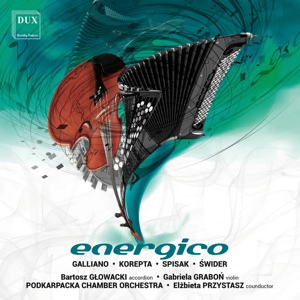
Energico
Richard Galliano (b. 1950)
Opale, Concerto for accordion and string orchestra (1994)
Paweł Korepta (b.1976)
Sinfonietta for strings and timpani
Michał Spisak (1914-1965)
Andante and Allegro for violin and chamber orchestra (1954)
Józef Świder (1930-2014)
Suite for accordion and orchestra (1979)
Bartosz Głowacki (accordion), Gabriela Graboń (violin), Podkarpacka Chamber Orchestra/Elżbieta Przystasz
rec. 2023, Wanda Kossakowa State Music School, Sanok, Poland
DUX 1952 [53]
I read an exceptionally interesting and well-written review of a previous recording of Richard Galliano’s Opale Concerto and when I looked to see who had written it, discovered it was me. So, with apologies to myself, and since it says everything I think about Galliano and his impressive work, let’s reprise it.
“Richard Galliano has long been a vibrant presence on the European scene, in particular, moving between classical and jazz ensembles with great facility and stylistic ease. As a performer he stands in relation to the accordion in the same way that Astor Piazzolla did to the bandoneon, taking the instrument, and the contexts in which it’s placed, in nourishing new directions. That he has worked with a raft of leading jazz players, from Ron Carter and Chet Baker to Jan Garbarek and Wynton Marsalis, gives some indication of his versatility as does the fact that he worked with Piazzolla himself, as well as with Juliette Gréco and Charles Aznavour. He is a chansonnier on his instrument and as both performer and composer always generates great, sometimes bittersweet melodies and often mines his Mediterranean background – like the great French violinist Zino Francescatti he is of Italian parentage.
His Opale Concerto for accordion and string orchestra dates from 1994 and is in three movements. As a master of the new French musette school – a later counterpart of Piazzolla’s Neuvo Tango – Galliano’s music is replete with abrupt rhythms and lashing strings, music of furious energy, some of which sound Balkan-Mediterranean in inspiration, along with organ-like sonorities. The slow movement offers a simpler narrative with two openly romantic-nostalgic themes, filmically beautiful, and suffused with a Left Bank spirit. Along the way Galliano ramps up the colour quotient, with a subtle balance maintained between the solo instrument and the orchestral strings. The finale is a passionate and youthful affair, slowing for a nostalgic B section with echoes of the slow movement – mysterious and warm.”
The Navona rival features accordionist Jovica Ivanović and the Ukrainian Chamber Orchestra under Vitaly Protasov and made a good impression but Bartosz Głowacki is even more impressive, not least in the sheer range of his tone colours, virtuosity and interplay with the Podkarpacka Chamber Orchestra directed by Elżbieta Przystasz.
This is the major work but there are three other Polish pieces to consider. The youngest composer, Paweł Korepta, contributes a Sinfonietta which is not dated in the notes. It’s a nine-minute compact piece that offers opportunities for the sections of the string orchestra to shine. After a rather sombre opening chorale, we get a double bass solo, clearly jazz-based, then the chorale returns as an interlocking device before other sections have their say. There are some neo-classical elements in this fresh and entertaining work that ends in a passionate restatement of the chorale, the timpani working overtime in support.
Michał Spisak is a much better-known composer whose early death robbed Polish music of a composer barely past 50 years of age. The Andante and Allegro was a commission from Nadia Boulanger for a course run by Yehudi Menuhin, who was teaching in Fontainebleau. It’s cast for violin and chamber orchestra and was written in 1954. Gabriela Graboń is the soloist and she is certainly both inside the idiom and up to its technical demands. It’s a bipartite affair, a rather withdrawn but characterful Andante followed by a lively and virtuosic Allegro where she pirouettes nicely, never afraid to sculpt opportunities for rather wan lyricism.
Głowacki returns for the last piece, Józef Świder’s Suite for accordion and orchestra, in four predominantly Baroque-titled movements: Toccata (spry, witty though full of drive), a Scherzo, a refined Canzona and the release of pent-up frustrations in a firefly Danza finale. Once again, the accordionist is a marvel of colour-conscious dexterity.
Accordion recordings tend to be on the short side, which is something to do with the relative paucity of repertoire, but this one is buttressed by engaging orchestral works played finely by the chamber orchestra and idiomatically directed by Przystasz.
Jonathan Woolf
Help us financially by purchasing from


















